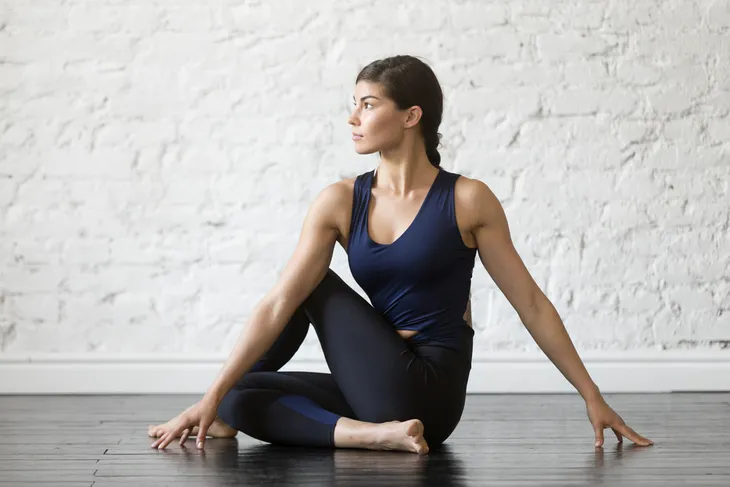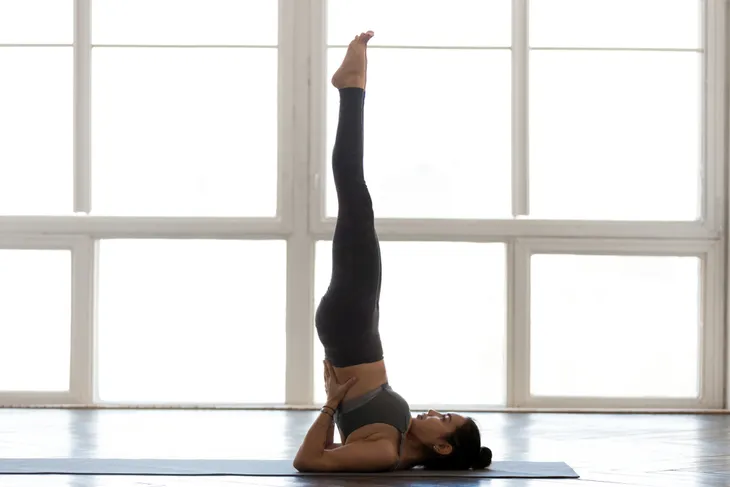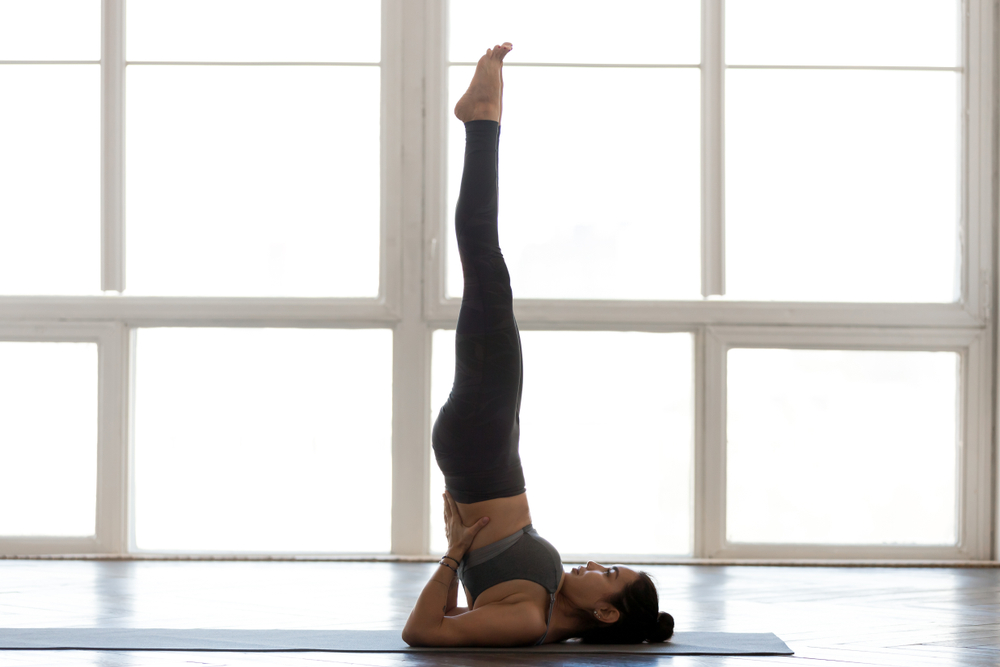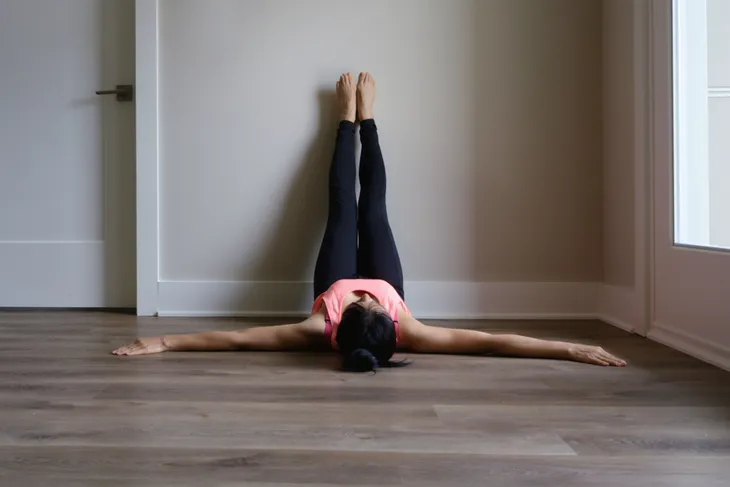You’re not alone if you’re already dreading the cold and flu season. Luckily, you can launch a preemptive strike on all of those coughy-sneezy germs swirling around your office, school, local market, and even your home with some proactive health measures.
For instance, I get my yearly flu shot, boost my fresh fruit and vegetable intake, make sure I get proper sleep, wash my hands frequently, and I sure as heck go to yoga class because getting all “downward dog” stimulates the body’s four major physiological links to the immune system—the digestive, endocrine, circulatory, and nervous system.
Here’s how the following 7 yoga poses done regularly can boost immunity and help ward off an impending cold or flu…
Alternate Nostril Breath Work
Sure, yoga breathing exercises can help you achieve Zen calm, but exercises that employ alternate nostril inhalation and exhalation work to break up and rid your nasal passages of stubborn congestion, germs, and bacteria. To perform a calming and cleansing session of alternate nostril breathing:
- Sit comfortably cross-legged, resting hands on thighs.
- Bring the right hand up to your nose and gently pinch the side of the nostrils with the right ring finger and thumb.
- Inhale and exhale, alternately closing off the right nostril with the thumb while you inhale fully through the left nostril.
- Then, closing off the left nostril with the ring finger to exhale fully through the right nostril.
- Count 4 beats with each inhale, hold for 4 beats, and exhale completely for 4 beats.
- Repeat for a round of 5 on each side.
Downward Facing Dog
In addition to providing a full body stretch (especially to those thighs and hamstrings), downward dog pose (or Adho Mukha Svanasana) works with gravity to encourage sinus drainage and in the circulation of white blood cells (your body’s immune fighters). To take downward facing dog pose:
- Begin in tabletop position with back flat, ankles over wrists, and knees under hips.
- Tucking your toes under, raise through the hips with the sit bones aimed at the ceiling.
- Heels should strive to reach the mat while palms press evenly into the mat with wrist creases facing parallel to the front of the mat.
- Head and neck should remain loose and long while you take 5 to 8 deep breaths.

Bow Pose
One of my favorite yoga poses, bow pose (or Dhanurasana) boosts overall immunity by placing gentle compression on the digestive system and abdominal organs, resulting in increased blood flow, in particular white blood cells, which fight germs and protect us from illness. To take bow pose:
- Lie flat, facing downward with your arms extended straight alongside your sides.
- Tuck chin to chest to extend and protect your neck with your forehead gently resting on your mat.
- As you bend your knees, reach back to grasp your feet or ankles.
- Gently raise your chin to lift your head, extend through the chest for greater lift.
- Press your feet into your hands, as you lift through your knees so that knees and chest are parallel to the floor.
- Breathe deeply into your belly for 5 to 8 long breaths.
Seated Spinal Twist
Twisting poses in yoga aim to flush toxins from the organs, particularly the immune system, and encourage fresh blood flow (and white blood cell circulation). The seated spinal twist (or Bharadvajasana twist) also provides a nice side and spinal stretch, widens the upper back and creates space between the shoulder blades. To perform a seated spinal twist:
- Sit on your mat with your legs extended straight out in front of you.
- Bending your right knee, place the foot on the outside of your left knee.
- Hug your right leg close with the left arm and place the right palm flat on the ground in line with the mid-behind (or sacrum).
- As you inhale, lengthen through the spine.
- As you exhale, twist more deeply for 5 to 8 full breaths.
- Repeat on the opposite side for symmetry.

Shoulderstand
Shoulderstand (or Salamba Sarvangasana) in yoga stimulates the endocrine system, immune system, and nervous system by gently compressing the thyroid gland (the butterfly shaped gland located at the lower throat) banishing stress and cleansing the body of foreign invaders. To take shoulder stand pose:
- First, fold over a soft mat or blanket to place under your shoulders, upper back, and neck for safety and cushioning.
- Lay on your back with arms extended straight at your sides.
- Lift your legs, bending at the hips, so they extend straight up to the ceiling.
- Pressing through the arms, swing your legs overhead, your knees can rest on your forehead.
- Place your palms under your lower back for support, press your elbows together, and lift your legs toward the ceiling keeping them extended as straight as possible.
- Remain in the pose breathing deeply and enjoying the reverse blood flow.

Bridge Pose
In addition to opening and creating space through the chest, bridge pose (or Setu Bandha Sarvangasana) increases activity in the thymus, the gland that supports immunity. To perform bridge pose:
- Lay flat on your back with your knees bent, feet flat on the ground at hip-distance.
- Extend your arms straight alongside the length of your body.
- Press through the feet to lift the hips as you lengthen through the tailbone.
- Interlace opposite hands and fingers under your sacrum, bringing your shoulder blades together.
- Press through the feet and shoulders/arms for lift for 5 to 8 long breaths.

Legs Up the Wall Pose
Yoga inversions purposefully position your heart over your head to flush the body with fresh lymph fluid and white blood cells to help strengthen immune function. To perform this invigorating pose, known as Viparita Karani:
- Position yourself sideways alongside an empty wall, lying down and facing away with your buttocks pressed firmly against the wall.
- Swing your legs up the wall, rolling over onto a flat back so you now face the wall
- With buttocks still firmly against the wall and arms alongside your body, breath deeply for 10 to 15 full breaths enjoying the reversal of blood flow.






